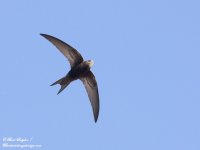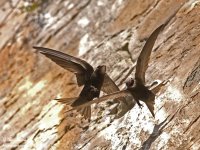-
Welcome to BirdForum, the internet's largest birding community with thousands of members from all over the world. The forums are dedicated to wild birds, birding, binoculars and equipment and all that goes with it.
Please register for an account to take part in the discussions in the forum, post your pictures in the gallery and more.
You are using an out of date browser. It may not display this or other websites correctly.
You should upgrade or use an alternative browser.
You should upgrade or use an alternative browser.
Swift and palid Swift? Alentejo region in Portugal (1 Viewer)
- Thread starter Bert
- Start date
More options
Who Replied?jforgham
Birding for fun
Hi Bert,
You may be correct here, but I would be expecting to see a blunter point on the wings to make it pallid. However, there appears to be white edges to the scaling effect, so one for and one sort of against. Therefore, I will go with pallid in one and common in the second. Both great shots, but I would have liked to see upperbody shots to make confirmation of pallid a tad easier.
Cheers,
Jono
You may be correct here, but I would be expecting to see a blunter point on the wings to make it pallid. However, there appears to be white edges to the scaling effect, so one for and one sort of against. Therefore, I will go with pallid in one and common in the second. Both great shots, but I would have liked to see upperbody shots to make confirmation of pallid a tad easier.
Cheers,
Jono
Simon Wates
Well-known member
I'm inclined to agree with Tom - for the 1st photo (nice!), even considering lighting and that the underwing is in shadow, the dark blackish-brown tones don't seem good for Pallid to me - though they can look cold toned in morning light. The white forehead and around eye could be the strong lighting - the bird doesn't seem or wide winged or hippy enough to me for Pallid. The 2nd photo (nice too!) seem to be clear CS.
While I agree with Tom and Simon on the first photograph (= Common Swift), the second photo gives the impression of two Pallid Swifts to me: these birds look browner, with the scaling on the belly being more prominent than that on the undertail coverts (the latter looking relatively plain).
Valéry Schollaert
Respect animals, don't eat or wear their body or s
Agree with Smith here, CS on the first photo and PS on the second.
Southern Frogmouth
Well-known member
Interesting as Pallid is meant to have the larger throat patch and obvious eye-mask, which the first photo has and the second doesn't. I guess it depends which features you attach most importance to. Both photos show scaling so all very interesting but hard for me to draw any firm conclusions from.
Roy
Roy
Tib78
Well-known member
Same feeling as Roy here regarding the birds in pic 2. The throat patch is narrow and seemingly does not extend very far onto the lower throat. I would not rely too heavily on colour shade since the light is clearly coming from above the birds. And the undertail scaling on the left bird look consistent with CS to me, while the position of the right bird makes the assessment of this peculiar feature difficult. Another somewhat subjective is the broadness of the head: again better for CS to my eyes.
Always tough on photo though (and not necessarily easier in the field!!).
Always tough on photo though (and not necessarily easier in the field!!).
Welsh Peregrine
Well-known member
I struggle to be certain when watching these two species unless I see the upperside of the wing, but if I had to call it on these shots I'd go for Common in both - largely on wingtip shape.
KenM
Well-known member
Thank you all for your opinions and complements! But it does not seem to be conclusive.........
It was conclusively..Inconclusive!
Simon Wates
Well-known member
I think its safe to call the first photo a Common Swift - concluded as such by most folk on this thread.
Compare with this photo with similar lighting - note structure of head and body, "paddle shaped" wings and underwing and under tail covert patterning: https://www.flickr.com/photos/j_frade/7477914852/
The 2nd photo is trickier......
Compare with this photo with similar lighting - note structure of head and body, "paddle shaped" wings and underwing and under tail covert patterning: https://www.flickr.com/photos/j_frade/7477914852/
The 2nd photo is trickier......
Last edited:
Bert
Birdwatchingalentejo.com
I think its safe to call the first photo a Common Swift - concluded as such by most folk on this thread.
Compare with this photo with similar lighting - note structure of head and body, "paddle shaped" wings and underwing and under tail covert patterning: https://www.flickr.com/photos/j_frade/7477914852/
The 2nd photo is trickier......
Thank you Simon!
Black Wheatear
Bowed but not broken, yet!
I'd have to agree with the majority in that the first photograph looks good for C.Swift. The second one I'd be relatively happy to put down as Pallid, BUT I'd still like a better photo collection i.e. upperside shots. One thing for sure, I find it easier to tell them apart in the firld than looking at these photos!
Peter
Peter
Southern Frogmouth
Well-known member
I checked the Advanced ID Guide and the tail structure is wrong for either of the photos to be Pallid, which is interesting. T5 is meant to be te same length as T4 in Pallid and clearly they aren't in the 2nd photo and the tail in photo 1 isn't looking too good either.
Cheers
Roy
Cheers
Roy
lou salomon
the birdonist
as for the 2nd pic i'm quite sure they are common swifts, too. small schin patch, small head, narrow hips, spointed wings and what roy says about rectrices (usually written as r4 = r5, not "T4/T5").
it's just that they look so warm brown because of lighting and background.
it's just that they look so warm brown because of lighting and background.
Users who are viewing this thread
Total: 2 (members: 0, guests: 2)






